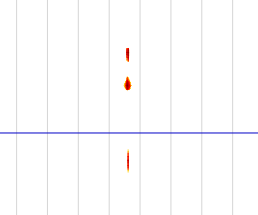|
Hello, I've recorded a DOSY data set and processed with Bayesian DOSY transform. There seem to be at least two peaks in the processed spectrum. Is the second one an artifact? In theory there might be a signal of H2O along with HDO, but wouldn't exchange of deuterium be much faster than the experiment time scale? edit screenshot of the dosy processed spectrum is below. D values are: 2.12, 1.97, 1.64 x 10(-5) cm2/s - top to bottom. edit2: Thanks, Adolfo. I do see slight phase distortion at the first two increments - where gradients are the strongest, actually I've ended up discarding them (but here all increments are included).
Thanks. |
|
If it's just D2O there should be only one peak. Yes, the chemical exchange in this case occurs much faster. What is the difference in chemical shift, amplitude, lineshape in both dimensions and apparent diffusion coefficients between the peaks? What do you see in a normal 1H, is it the same? I would expect that the second peak is a much smaller one with a distorted lineshape, difficult to distinguish from the baseline. In this case you have a very large vertical scale. If the peak does not appear in a pulse acquire experiment, it may be caused by effects like temperature instability or phase variations (such those generated by eddy currents, tipically observed for low gradient stabilization delays). Thanks, Adolfo. I'll post up the spectrum a bit later today. - Evgeny Fadeev (Aug 28 '10 at 09:23) That's a bizarre plot. From what I read of the Bayesian DOSY I assumed that it would do a monoexponential fitting, but those peaks apparently have the same chemical shift (unless it's a display problem). Can you increase the frequency resolution? - Adolfo Botana (Aug 31 '10 at 11:47) 2 possible reasons come to my mind for having a multiexponential decay: slight convection (you would see phase distortion and high D, your D is slightly above normal for 25ºC, but probably that's because of gradient calibration), and gradient non-uniformity. I would check it in VnmrJ or DOSYToolbox. - Adolfo Botana (Aug 31 '10 at 11:54) Thanks. What is the correct Diffusion constant number for HDO? - Evgeny Fadeev (Aug 31 '10 at 12:11) 1.90 10(-5) cm2/s http://onlinelibrary.wiley.com/doi/10.1002/cmr.10026/abstract - Adolfo Botana (Sep 01 '10 at 07:24) |






